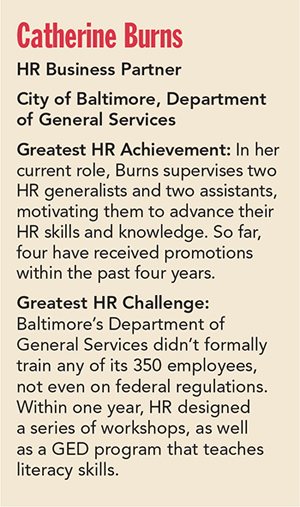This article accompanies Agents of Change.
On the first day of her job as the HR business partner for the City of Baltimore’s Department of General Services, Catherine Burns recalls how concerned the DGS director, Steven Sharkey, and chief of staff, Gary Holland, were about a mass exodus. Nearly 75 percent of the staff was eligible for retirement.
“For an agency that’s all mechanics and building repairs, that could end up hurting us,” she says, adding that HR now examines its retirement rate every two months and kicks up recruitment when needed. “We also wanted to know why employees in DGS’ four divisions–administration, facilities, major projects and fleet management–wanted to stay. What did they like about the culture?”
Burns joined the city in 2008 as an intern. The following year, she was hired as a personnel generalist and then promoted to her current role in 2014. Since then, she’s made significant HR changes involving training and development, succession planning and employee engagement. She is considered the department’s go-to person for any personnel-related action.
Under Burns’ leadership, HR developed a stay-interview process, in which members of her team conduct face-to-face interviews with 350 department members about their likes and dislikes of their jobs. HR then analyzes this information and shares it with each division chief so internal adjustments can be made about training, job assignments, office culture or anything else that would attract and retain skilled workers.
So far, employees in three out of the four divisions have been surveyed, in addition to new hires after six months on the job. Employees also respond to a Gallup poll referred to as Q12 that asks unique questions such as, “Do you have a best friend at work?” Burns says this process helps keep turnover low, which she projects to be less than 15 percent.
Boosting Morale and Engagement
For many years, DGS supported a customer-service committee that consisted of two members from each DGS division. But when Burns came on board, she changed the committee’s name and focus to employee engagement, which aims to increase engagement and morale through employee recognition.
Three years ago, the employee-of-the-month program was launched across the company. Any employee can nominate a peer or supervisor, and the committee reviews the nominations, selecting one person per month from all four divisions. The winner receives a certificate and one day off from work.
Another HR initiative–the Allstars program–was introduced last year. Every month, each division chief recognizes an individual or entire team. Besides receiving a certificate, division chiefs generally treat winners to lunch, or if it’s a team, a pizza party.
“Top leadership makes sure [division chiefs] go to each other’s events so employees know [they’re seen] as important,” Burns says.
So Much Left to Do
With a bachelor of science degree from Penn State University in business administration, Burns believes she has a “nice foundation” for the HR field, since her education exposed her to various aspects of finance, management and marketing, which complement HR. Her master’s degree in HR development from Towson University also prepared her for advanced HR positions.
But Burns says there’s more she hopes to learn and accomplish. Besides her degrees, she also earned a professional HR certification and was named a certified professional by the Society of HR Management. She is also planning to obtain a senior professional in HR designation, the highest HR certification.
Meanwhile, Burns is getting her feet wet in mediation and arbitration.
“If, in 20 years, someone says, ‘Catherine, here’s a great opportunity … to be director of some big, huge organization,’ I want to jump at it,” she explains. “I want to have those skills behind me, helping union or non-union employees have fewer issues amongst themselves.”
Holland, who’s also Burns’ boss, says she now works closely with the city’s labor commission on employee-relations issues. She appears to have a natural ability to present management’s viewpoint to bargaining units and negotiate fair compromises or resolutions, Holland says.
But that’s only part of her career plan. Burns is determined to build the best HR office within the city of Baltimore by creating a knowledgeable and skilled HR team from the ground up. Whether employees walk in off the street with a high-school diploma or if they apply with advanced college degrees in HR, she says, “We all have a little bit we can give and learn from each other.”
Regardless of her role or responsibilities, Burns is committed to evolving the HR profession.
“Until people recognize HR as a true profession, not just a bunch of paper pushers … they’re not going to understand our importance,” Burns says. “The more my director and chief of staff see the importance of HR, the more the environment expands, the more I’m going to hopefully see that HR has a seat at the table and is seen as a profession just like lawyers, nurses or teachers.”
Holland says Burns has definitely earned her seat at the leadership table–so much so that he can easily envision her as the city’s future chief human capital manager.
“She excels in the human-capital side of things,” he says. “People recognize that she knows what she’s talking about and looks out for their best interests. She is well-respected … and really helps us come to the best decisions.”

